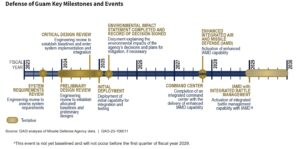
The latest annual Government Accountability Office (GAP) review on missile defense acquisition progress showed more details about the new defensive plans for Guam including the specific command and control systems that will be used. Last year, MDA announced the architecture it decided on to defend Guam from air and missile threats will include mobile unit versions of the Aegis Combat System, Raytheon Technologies [RTX] Standard Missile (SM)-3 and SM-6 missiles, and the Northrop Grumman [NOC] IBCS while also maintaining the…

 By
By 











